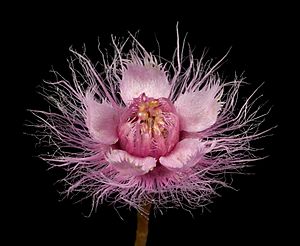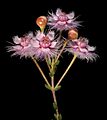Verticordia insignis facts for kids
Quick facts for kids Verticordia insignis |
|
|---|---|
 |
|
| Verticordia insignis subsp. compta | |
| Scientific classification | |
| Genus: |
Verticordia
|
| Species: |
insignis
|
| Subspecies | |
|
See text |
|
Verticordia insignis is a beautiful flowering plant. It belongs to the Myrtaceae family, which also includes myrtle trees. This plant is special because it only grows in the south-west part of Western Australia.
It's a shrub that doesn't grow in a perfectly neat shape. It has small leaves and lovely pink or white and pink flowers. These flowers appear in groups at the ends of its branches, usually in spring.
Contents
What Does Verticordia Insignis Look Like?
Verticordia insignis is a shrub that can grow up to about 1.5 meters (5 feet) tall. Its branches spread out in an uneven way.
Its leaves are thin and can be shaped like a line or an oval. They are also a bit triangular when you look at them from the side. These leaves are usually between 3 and 7 millimeters long. Leaves closer to the flowers are often wider than those further down the stem.
The Flowers of Verticordia Insignis
The flowers of this plant have a nice smell. They grow in round, cluster-like groups at the end of the branches. Each flower sits on a stem that is about 8 to 25 millimeters long.
The part of the flower that holds everything together, called the floral cup, is shaped like a top. It's about 4.5 millimeters long and covered in soft, short hairs.
The sepals, which are like small leaves that protect the flower bud, are white or different shades of pink. They are 5 to 7 millimeters long and spread out. They have five to seven fuzzy parts. The petals are shaped like eggs or are almost round. They are pale to deep pink, 3 to 5 millimeters long, and spread open. Their edges have tiny teeth. The style, which is part of the flower's reproductive system, is mostly straight and smooth. It is about 2.5 to 7 millimeters long. Most of these flowers bloom from September to November.
How Was This Plant Named?
The plant Verticordia insignis was first officially described in 1837. This description was made by a scientist named Stephen Endlicher. He published it in a book after specimens were found near the Swan River.
Later, in 1991, another scientist named Alex George studied the Verticordia group of plants. He placed Verticordia insignis into a specific subgroup called Verticordia section Catocalypta.
Different Types of Verticordia Insignis
In his study, Alex George also found three slightly different types, or subspecies, of Verticordia insignis:
- Verticordia insignis subsp. insignis: This type has white sepals. Its style and petals are a certain length, and its upper leaves are typically longer.
- Verticordia insignis subsp. compta: This type is similar to subsp. insignis but has pink sepals. Its stamens (male parts) and style (female part) are shorter, and its upper leaves are also shorter.
- Verticordia insignis subsp. eomagis: This type stands out because it has longer sepals, slightly longer petals, and longer stamens and style compared to the other two subspecies.
The name insignis comes from a Latin word. It means "remarkable," "notable," or "eminent." This suggests that the plant was considered special when it was named.
Where Does Verticordia Insignis Grow?
This verticordia plant often grows alongside other verticordia species. You can find it in grey or yellow sand, usually near rocks. It lives in areas called heathlands and woodlands.
It grows along the Darling Scarp and stretches inland to places like Northam and Brookton. These areas are part of different natural regions in Western Australia, including the Avon Wheatbelt, Coolgardie, Jarrah Forest, Mallee, Geraldton Sandplains, and Swan Coastal Plain.
Protecting Verticordia Insignis
The government of Western Australia keeps track of how many of these plants exist. The two subspecies, insignis and compta, are considered "not threatened." This means there are enough of them, and they are not in danger of disappearing.
However, the subspecies eomagis is classified as "Priority Three." This means we don't know as much about it, and it's only found in a few places. While it's not in immediate danger, it needs to be watched carefully.
Can You Grow Verticordia Insignis?
People are interested in growing Verticordia insignis in gardens because its flowers are so beautiful. They are often described as looking like "miniature powder puffs."
Gardeners have tried to grow this plant from cuttings, which means taking a piece of the plant and growing a new one from it. However, it has been tricky to get these plants to grow well in home gardens.
Images for kids



